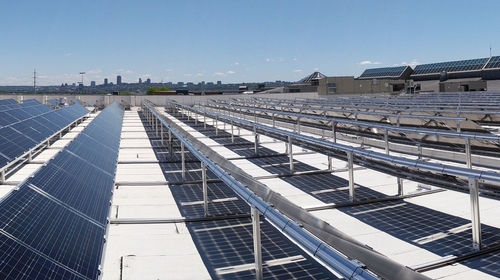Bifacial Gain and Albedo: How Smart Racking Design Captures More Sunlight
28 May 2025

When designing solar systems for flat rooftops, energy yield is often treated as a fixed outcome—something that's already been optimized by the choice of modules and orientation. But in reality, there's an untapped source of energy sitting just beneath the panels: reflected sunlight.
If you're working with bifacial modules, you already have the technology to harvest light from both sides. The real question is: Is your system design helping—or hurting—that potential?
What Is Bifacial Gain, Really?
Bifacial modules aren't just a trend—they're built to generate electricity from both the front and back. While the front catches direct sunlight, the back relies on what's reflected from the roof below. This rear-side production is known as bifacial gain, and depending on how the system is designed, it can boost total output by 5 to 30%.
Why Albedo-Friendly Design Changes Everything
Many flat roof systems unintentionally block or limit bifacial gain without even realizing it. A few common design habits are often to blame:
-
Wind deflectors that block natural airflow—and reflected light
-
Low-clearance mounting, which prevents light from reaching underneath
-
Tight spacing between panel rows, causing shadows and limiting reflection
These seemingly minor choices can reduce rear-side production to nearly zero—essentially turning bifacial panels into expensive monofacials.
So what does a good design look like?
It starts with elevation. Give the system room to breathe and light the space beneath. Add generous row spacing, and steer clear of bulky shading elements like deflectors. Every decision should support one goal: letting light bounce back up to the panels.
Reflective Surfaces Matter—But Only If You Let Them Work
Your roof's surface also plays a big role. Albedo—a measure of reflectivity—can give bifacial modules a huge boost, especially on white TPO membranes or light-colored coatings. But again, design is everything. If your system is pressed flat to the roof, it won't matter how reflective the surface is. The light simply won't make it back to the panels.
➡️ Curious how winter conditions impact this too? Read: Snow and PV Panels – Challenges and Best Practices.
Let the Light Work—From Both Sides
In the end, bifacial modules need the right environment to thrive. Good design can't be an afterthought. It should elevate the system—literally and figuratively—so every ray of light has a chance to contribute to the performance of your system.
If you're aiming to get the most out of your flat roof solar array, it's not just about what panels you choose.
It's about how you set the stage for them to shine from both sides.